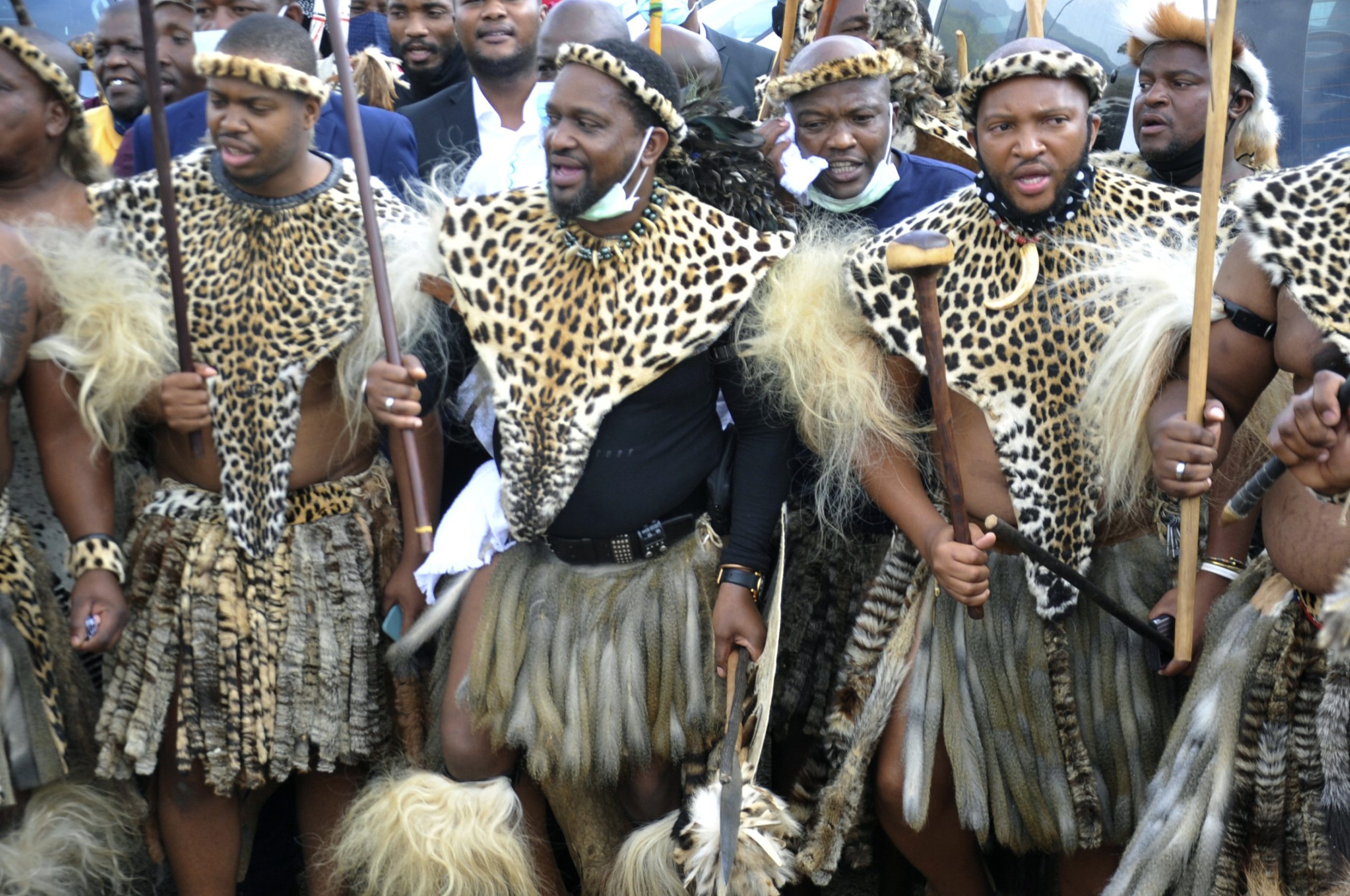
Although we have grown up in a Eurocentric culture, we now know that in the time of the Romans and Greeks, great civilisations flourished in Africa, led by ultra-centenarian monarchies. The expansion of the Sahara desert, colonialism and the slave trade have erased almost everything. The Zulu people are an extraordinary and complex exception, especially due to the fact that the Republic of South Africa, born from the ashes of Apartheid, has allowed the Zulu monarchy (which in itself is absolutist in nature) not only to survive and receive economic support from the state – as is also the case with European ruling houses, which have ceded almost all powers to their respective parliaments – but to continue to play an active political and social role.
The centre of the monarchy is in the Province of KwaZulu-Natal – perhaps the most beautiful and untouched region of the huge African country, the one in which the tribal organisation is able to victoriously oppose the political decisions of the state and which, even when forced to accept the decisions of the South African judiciary, finds a way to circumvent it. This fact, which from a cultural anthropological point of view is fascinating, from a political point of view creates an instability that continually risks escalating into violence. This was prevented for almost half a century by the fact that King Goodwill Zwelithini had firm agreements with the ANC and the IFP (South Africa’s main opposition party, founded by the Zulu King to have an institutional presence). When he died, the cap blew off, and today KwaZulu-Natal is a ticking bomb that is liable to explode at any moment.
The reason why this happens in native Kwa-Zulu is ethnic. South Africa’s blacks are mainly divided into the Nguni[1], Sotho[2], Shangaan-Tsonga[3] and Venda[4]. The Nguni, who make up almost two-thirds of the black population, are divided into four distinct groups: the Northern and Central Nguni (the Zulu-speaking peoples), the Southern Nguni (the Xhosa-speaking peoples), the Swazis of Swaziland and adjacent areas and the Ndebele of Northern Province and Mpumalanga[5].
For three centuries, these ethnic groups have agreed on a common monarchy – and this agreement essentially survives. All tribes have the same characteristics: they are sedentary and, when their Imizi (family farms) grow too large because of their offspring, they build a Kraal (i.e. a communal animal enclosure)[6], which becomes the centre of what becomes a village. Each Kraal, once it has reached a certain number of inhabitants, elects its nKhosi, who is not a nobleman, but is the delegate to represent the Kraal in the amaKhosi (i.e. the assembly of the Kraals of a certain geographical region[7] who, in turn, appoint Imbizo, who over the years will carry the voice of the villages to the King’s Court)[8].
The foundation of the Kingdom and the war with the Boers
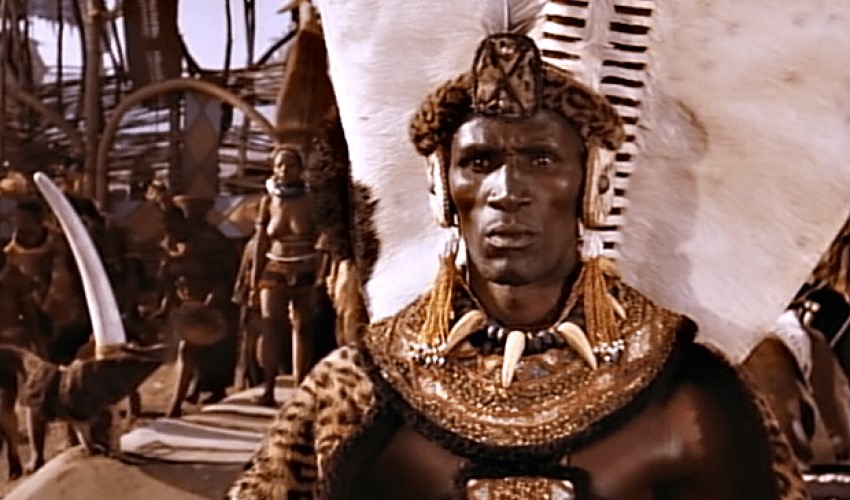
King Shaka, in a 1986 film reconstruction, played by actor Henry Cele[9]
The Zulu monarchy was born at the beginning of the 19th century thanks to the wars waged by the King of the Nguni, Sigidi kaSenzangakhona, known as Shaka (or Tshaka): the bastard – a nickname he obtained as a child[10] because he was born from an orphan princess and a disgraced nKhosi[11]. Chased out of his Kraal with his parents (their marriage was not valid according to the rules of the Mthethwa tribe) with whom they lived[12], he enlisted in the IziCwe regiment, distinguishing himself by his skill and total lack of pity[13]. Having become a favourite of King Dingiswayo, Shaka gains support to usurp the throne from his heirs, and becomes leader of the Zulus when Dingiswayo is captured and killed in a tribal war in 1818[14]. Shaka avenged him by annexing the entire region of Natal and Swaziland[15].
Shaka founds a new capital, KwaBulawayo[16], and practising a policy of extermination and raids (more than one million dead are said to have been killed), enriches and makes his people loyal[17]. When, in 1824, the first British landed, determined to colonise the area, the British army avoided any confrontation, making cooperation agreements[18]. Thus, two days’ ride from KwaBulawayo, the first European city was born: Port Natal, later renamed Durban[19]. Shaka would never break the peace with the British[20], but this did not change his destiny: when his mother died in 1827, Shaka buried her along with ten live girls and ordered the execution of more than 7000 subjects considered insufficiently grieving[21]. On 22 September 1828 one of his bodyguards stabbed him to death[22].
Shaka left an enormous legacy: he transformed a small and insignificant Zulu kingdom into one of the most powerful dynasties in African history, with more than 250,000 subjects at his death[23]. His legendary figure inspired novels and historical studies and is still the basis of the Zulu king today. He died at a time when the Boer community (from the Dutch buuren, meaning farmers) was being strengthened in the Transvaal, a people made up of migrants of Dutch, German and Huguenot origin, who arrived for the first time in 1652, when the first port of call for the supply of trade ships linking Holland to the East Indian colonies was established at the Cape of Good Hope[24]. Forced by English harassment to leave Cape Town, the Boers, around 1835, moved to the Transvaal and came into contact with the Zulus[25]. King Dingaan, Shaka’s successor, massacred 70 shepherds who had come to negotiate the purchase of land for the Boer people, because he feared that the meeting was a trap[26].
War broke out: Dingaan marched at the head of 15,000 men against the Boer settlements at the foot of the Drakensberg mountains, killing everyone in their path, including women and children[27]. The Boers counter-attacked and were defeated at the gates of the old capital of Mgungundlovu[28]. On 12 August 1838 the final battle is reached. The Boers, commanded by a career officer, Andries Pretorius[29], stood on the banks of the Ncome river and waited patiently: this time they had rifles and cannons, while the Zulus had only spears and old muzzle-loading muskets, and three thousand of them left their lives in what would be called the Battle of Bloedrive (river of blood) [30]. From then on, Dingaan limited himself to defensive skirmishes, and on the 20th December 1838, Pretorius triumphantly entered Mgungundlovu[31].
Mpande, Dingaan’s brother, sides with the Boers and, in the battle of Maqongqo, on the 29th January 1840, together with Andries Pretorius[32], is defeated, deposed and killed while fleeing to Swaziland[33]. Mpande is now King, but of a small kingdom, comparable to American Indian reservations, and is subject to Boer laws[34].
The English wars against the Boers and against the Zulus

A battle scene from the Second Boer War (1899-1902) drawn by R. Caton-Woodville[35]
The peace ended when his two sons, Cetshwayo and Mbulazi, fought at the head of two factions that clashed in the battle of Ndondakusuka Kraal in 1856[36]. Cetshwayo wins and Mpande, feeling threatened, asks the British for help[37]. A British official, Theophilus Shepstone, persuaded Cetshwayo to swear loyalty to his father and renounce the throne until Mpande’s death in 1873[38]. This agreement formed the basis for subsequent agreements which, by recognising British military supremacy, convinced the Zulus to join the Union of South Africa[39]. A peace betrayed by the British in 1879, which led to the annihilation of the Zulu army and the violent annexation of the territories controlled by Cetshwayo[40].
An annexation paid dearly: in the battle of Isandlwana 25,000 Zulu warriors massacred the English garrison of 1350 men[41]. London sends a huge army that, on 4 July 1879, annihilates the army of Cetshwayo[42], who is captured and forced into exile[43]. The new governor, Garnet Worseley, divides South Africa into 13 provinces, for each of which he appoints an nKhosi of his preference, hoping in this way to crush the resistance[44]. He has the opposite result: his choice falls on traitors, corrupt officials and deserters[45], bringing the country back to the brink of civil war[46].
Cetshwayo was called in to mediate and returned to KwaZulu-Natal in January 1883[47]. The operation turned out to be a failure: his opponent, Zibhebhu, won the war[48] and forced Cetshwayo to flee again[49]. The king died on 8th February 1884, poisoned[50]. His 15-year-old son, Dinuzulu, inherited the throne and made an alliance with the Boers, promising them land in exchange for help. He remained in office until his death in 1913, but although he obtained an acceptable peace treaty, and the execution of the leaders of the uSuthu rebellion[51], he lost all independence. When his son, Solomon kaDinuzulu, ascends the throne, he has lost all power, and is considered equal to the other nKhosi[52].
After the discovery of the Kimberley diamond mine in 1872, the Boers and British clashed[53]. The alliance between Zulus and Boers produced a surprising result: allies because they were perceived as natives, while the British were the invaders[54]. The Boer anger leads to a clash that, in February 1881, will see the British defeat at Majuba Hill[55]. This did not stop the wave of engineers, gold miners and traders who, after further mining discoveries in the Transvaal, brought thousands of migrants from all over the world from 1884 onwards[56]. The Boers refused to grant them citizenship[57]. The “Uitlanders” (foreigners), who founded dozens of villages, revolt, but their rebellion is bloodily crushed in the spring of 1896[58].
The migrants are defended by the British Crown. After a series of skirmishes and ultimatums, the two Boer provinces of the Transvaal and the Orange Free State decide to declare the “Second Anglo-Boer War” on 11 October 1899[59]. After a series of bloody battles, which at first seemed to see the Boers close to victory and finally saw the British conquer all the Boer lands[60], the Boers switched to guerrilla warfare[61], which would be repressed with the devastation of over 30,000 farms and 40 villages[62], thousands of prisoners tortured[63] and the construction of 18 concentration camps in which, in a few months, 42,000 civilians would die[64]. On 31 May 1902, the Treaty of Vereeniging sanctioned the birth of the Union of South Africa as a British colony[65] and granted the Boers, in return for their surrender, the return of their villages and a subsidy of £3 million (about £175 million today) for reconstruction[66]. In all this, King Mpande of the Zulus remained equidistant, and refused to become involved in the war[67].
During and after the Apartheid years
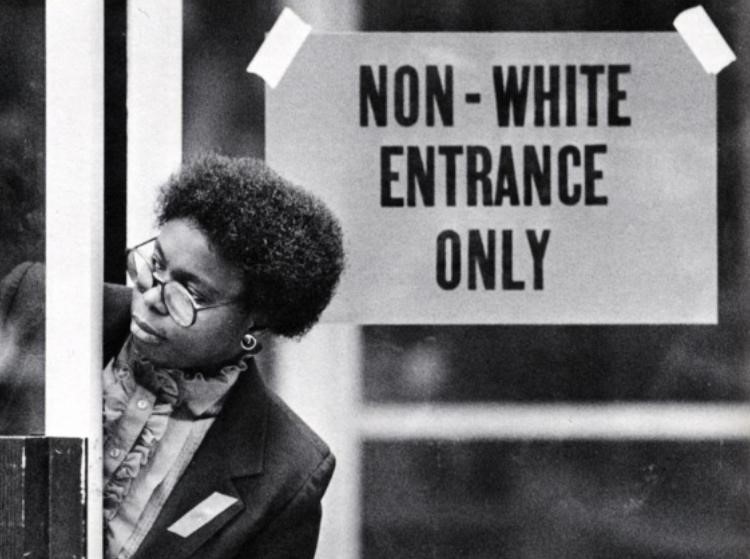
Photo depicting one of the notices dictating behaviour during apartheid[68]
From 31 January 1906, the Land Demarcation Commission[69] allocated two-fifths of Zululand’s land to whites. The Zulu occupants become tenants, or are deported to reserves[70]. The discontent continues, especially after the Pretoria government’s decision to open South Africa to Chinese migrants, but all is limited to sporadic acts of violence[71]. In 1892, the Franchise and Ballot Act was introduced, limiting the right to vote to blacks[72]. In 1894, with the Natal Legislative Assembly Bill of 1894, these restrictions were extended to Indian immigrants[73]. In 1905, the right to vote was completely cancelled with the General Pass Regulations Bill[74], followed by the humiliating Asiatic Registration Act (1906): from now on, blacks and Indians must always carry a pass, under penalty of severe fines[75].
In 1902, Abdullah Abdurahman founded the African Political Organization (APO) [76], which represented the mestizos and the black community. In 1910, with the promulgation of the South African Act, the years of racial segregationism begin[77], controlled by the white party in power, the South African Party (SAP) of Louis Botha[78]. In 1911 the Mines and Works Act was passed, reserving mines and railways for white workers only[79]. In 1913 it was the turn of the Natives Land Act which prevented blacks from owning and renting land outside designated reserves[80]. In 1923, the Natives (Urban Areas) Act defined urban blacks as “temporary sojourners” who were only welcome as long as they served “the needs of the white population”[81].
Blacks do what they can: on 8 January 1912, the National Congress of Native South Africans (SANNC) is founded to unite all blacks in the defence of their rights[82]. After the First World War, the racial laws were tightened[83],, so that the economic and industrial growth of the following years did not rely on workers, but on slaves[84]. The blacks have to attend separate schools, universities, sports venues, means of transport, and are forbidden to have sexual relations with whites – and the South African Communist Party (SACP) is banned: many of its exponents will join the ANC[85].
The Zulus are in disarray, enslaved in the townships, shanty towns on the outskirts of the white cities, where they work as servants or miners[86]. The blacks are divided: most of them join the ANC, the Zulus join a secret society, called Inkatha, which only in 1990 will become a real party of the monarchy (Inkatha Freedom Party), whose programme is the restoration of the kingdom created by Shaka[87]. Paradoxically, being more interested in Zulu identity than in the need for freedom and equality, Inkatha will be a formidable ally of the white SAP[88]. The struggle between Inkatha and the ANC costs 20,000 dead and ends only with the first democratic elections in 1994, and thanks to the charisma of Nelson Mandela[89].
When Madiba wins the presidential elections, he and De Klerk face a seemingly impossible task: to transform 300 years of tribal warfare into the history of one people, and to do so through forgiveness and mutual empathy. The new constitution reflects this effort and, following the black mentality, provides for a parliamentary republic, but with the singularity of having the figure of the head of state and that of the government coincide[90]. The first measure, even before the new laws in favour of the blacks, was to erase the hateful geographical divisions desired by the British, first and foremost the reserves[91].
Today, South Africa is a federal state with nine autonomous provinces, one of which, KwaZulu-Natal, is populated by almost four-fifths of the Zulu ethnic group, and has an administrative structure different from the other provinces, because it is monarchical: the province was born following the boundaries of the Boer Republic, unifying the bantustan of KwaZulu (established in 1970) and the province of Natal. Alongside the provincial parliament, democratically elected, the province has a head of state appointed by dynastic succession: King Goodwill Zwelithini kaBhekuzulu, who remains in office until the age of 72 when, on 12 March 2021, he dies of Covid[92].
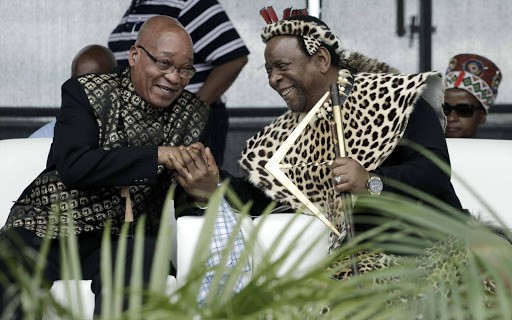
President Jacob Zuma with Zulu King Goodwill Zwelithini[93]
The Constitution mediated by Madiba gives Zwelithini a real kingdom, included as such, in 1996, in Chapter 12, which recognises the political and institutional role of the Zulu king and limits his powers, leaving to democracy those of the management of justice, defence and economic policy[94]. The ANC grants a position as Minister of the Interior in the first Government of National Unity to Chief Mangosuthu Gatsha Buthelezi, former head of the KwaZulu Legislative Assembly and leader of the IFP (Inkatha Freedom Party) [95]. It is not a random choice: Zwelithini is the King, but Buthelezi has always been his greatest adversary, because the former is only interested in restoring pre-colonial traditions, while the latter, within a democratic system, is fighting for a situation of quasi-independence for KwaZulu-Natal – which means no more subsidies to the Royal House[96].
In 1975 Buthelezi accused Zwelithini of interfering in IFPO and ANC politics, and in 1979 even of conspiring to overthrow democracy together with the Mozambique government[97] and attempting to replace one of his men, Mhlabunzima Maphumulo, as head of the whole of South Africa[98]. Buthelezi, as head of the Legislative Assembly, lowers his salary – a bloody insult[99], which forces the SAP government, in order to avoid a civil war, to force Buthelezi to stop[100].
On 28 March 1984, IFP leaders Themba Khoza and Humphrey Ndlovu organise a demonstration against Apartheid. Thousands of Zulus make their way to the centre of Johannesburg, some of them approaching the ANC headquarters, Shell House. Something goes wrong, shots are fired, 19 Zulu protesters die[101]. According to the ANC, Shell House was a defensive shooting, but this is denied by the Commission of Inquiry[102]. In June 1995, the ANC and then-President Nelson Mandela admitted giving the order to shoot[103]. The eleven ANC members responsible for the killings will be amnestied[104].
The dispute, however, remains, even more exacerbated. A meeting between Chief Buthelezi, King Zwelithini, and the parties fails miserably[105]. Buthelezi called for international mediation: the intervention of the Kenyan diplomat Washington Okumu, who succeeded in the reconciliation[106]. He will do so by accepting secret clauses, which will only be known years later, and which have forever changed the face of KwaZulu-Natal: the IFP is granted the role of monarchical party and some constitutional changes that strengthen the role of King Zwelithini to the detriment of the intrusions of Buthelezi – but the key to the agreement is the creation of a royal fund to administer millions of hectares of land, a request kept secret from the ANC and public opinion[107]. The agreement was signed by De Klerk, who confronted Madiba with the fact: the civil war was over, but the Ingonyama Trust was born[108].
On 28 April 1994 the ANC wins with 62.65% of the votes, and Mandela forms a Government of National Unity[109]. The redistribution of land goes under state control, except for that of KwaZulu-Natal: according to the 3KZ Act of 1994, about 2.8 million hectares (26.9% of the province’s territory, a territory the size of England) become a trust with the Zulu king as sole trustee[110]. Zwelithini is thus freed from the influence that Buthelezi had over its revenues[111].
The Ingonyama Trust
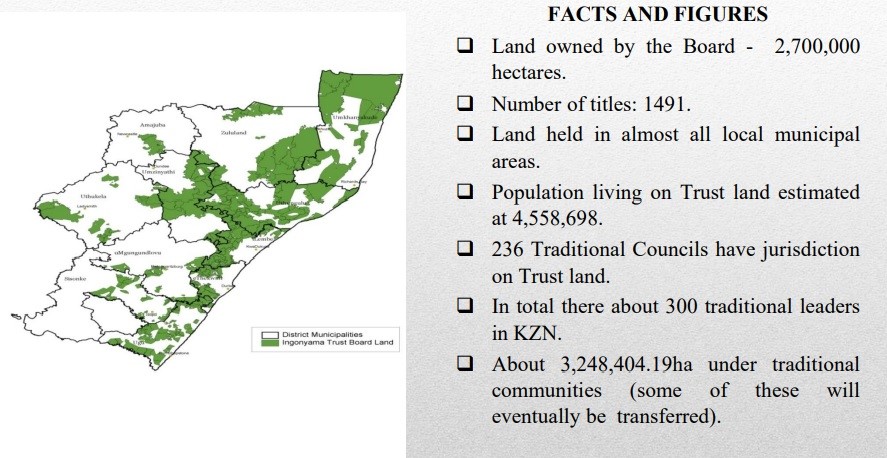
The plan of the land allocated to the Ingonyama Trust by the 1994 Act
The agreement is made public after the elections, and produces angry reactions. But by now peace is made, Mandela is president and everyone agrees to calm the waters[112]: The Ingonyama Trust comes into force on 2 October 1998. According to the Ingonyama Trust Amendment Act 9[113], the trust fund is administered by the King together with eight members appointed by the Minister of Agriculture, Agrarian Reform and Rural Development of the National Government, after consultation with the King, the Premier of KwaZulu-Natal and the President of the KwaZulu-Natal House of Traditional Leaders[114]. Black people living on these lands are issued with a Right to Occupy Certificate (PTO) [115], but the proceeds of the land are now administered by the King: ‘Ingonyama (the King) is the sole trustee of the land […] the Trust land accrues to the King as trustee on behalf of the members of the communities’[116].
One of the purposes of the Trust is to create a class of nobles (the amaKhosi), who receive part of the income and can then live off these tithes[117]. Most of these lands were expropriated from whites under Article 25 of the Constitution: “A person or community whose form of possession of land is legally insecure because of previous racially discriminatory laws or practices shall be entitled, to the extent provided by an Act of Parliament, to a possession which is legally secure or to comparable compensation”[118]. The land passed to the Ingonyama Trust and, over time, increased in value, greatly increasing King Zwelithini’s wealth and power, especially when this land was ceded for mining exploitation.
After a quarter of a century, tensions and scandals surrounding the Ingonyama Trust Board (ITB) [119] have ended up in court, but the initial constitutional contradiction prevents any solution being reached. The equivalence of the King’s and the State’s power leads to judgments against ITB that the King then fails to fulfil – which only increases anger, frustration and violence between the different tribes. For this reason, a federal report published on 21 November 2017 calls for the repeal of the PTO concept and its replacement with full property rights, accusing ITB of “encouraging” occupiers to surrender their Permission to Occupy (PTO) rights in exchange for leases, which turns peasants back into slaves[120].
In October 2018, Auditor General Kimi Makwetu accuses the Ingonyama Trust board of failing to provide supporting documents relating to land worth 1.08 billion rand (about €60 million) [121]. In November 2018, the Council for the Advancement of the SA Constitution (CASAC), an organisation for the defence of the Constitution[122], in collaboration with the Rural Women’s Movement in KwaZulu-Natal, denounced the fact that some 5 million residents on trust land were allegedly forced under duress[123] to enter into leases and pay rents to the King[124].
The figures are impressive: 71 million rand in 2015, 96 million rand in 2016 and 107 million rand in 2017 (almost 6 million euros) [125]. Many residents, especially women, unable to pay, have been illegally evicted[126]. Some lands have been expropriated and leased to mining companies, from which royalties are demanded for the exploitation of the subsoil[127]. Not bad for land that the occupants own by constitutional right, considering that the illegal leases have been in place since at least 2007[128].
Research by the Land and Accountability Research Center at the University of Cape Town points the finger at traditional leaders who allegedly used their position to harass their subjects[129]. In September 2020, the Minister of Agriculture, Thoko Didiza, launches an investigation into the financial affairs of the ITB and its chairman, Jerome Ngwenya, who is accused of unlawfully enriching himself[130]. In January 2021, the Auditor General of South Africa (AGSA), Thabo Ditodi, comments on the results of the investigation: incorrect procedures in the management of supplies, irregular expenses, no control over conflicts of interest, contracts obtained without requests for estimates[131].
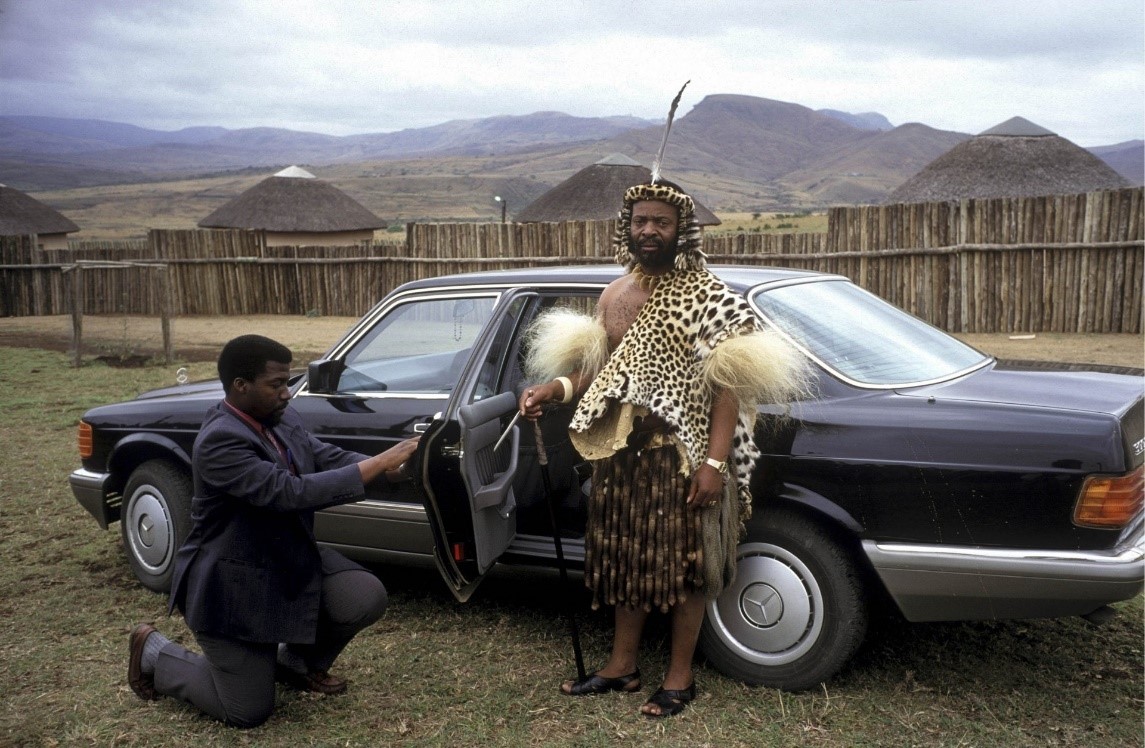
Re Goodwill Zwelithini al KwaKhethomthandayo Palazzo Reale a KwaNongoma[132]
On 11 June 2021, the High Court of Pietermaritzburg issued a ruling against the leasing practices[133]: the judges stated that ITB was acting in open violation of the Constitution[134]. The magistrates complain that the behaviour of the Minister of Rural Development never intervened to stop such practices, as it should have done[135]. The Court also orders ITB to return to residents the sums misappropriated through the leases[136].
In addition to the illegal rents, until 2017 King Zwelithini received an annual emolument of 58.8 million rand from the government, increased to 65.8 million rand in 2018 (3.65 million euros); in 2020 a new increase of 4.5 million rand is announced and the figure rises to 71.3 million rand, the equivalent of over 5 million dollars[137]. No one has ever asked the king to account for the use of this money[138].
The shower of money continues. In 2013, 20 million rand was allocated for the maintenance of the royal family’s palaces, and it is not known how it was used[139]. According to the Sunday Times in 2014 10.3 million rand was allocated for the royal palaces, 2.2 million rand for the salaries of his six wives, 2.5 million rand for travel expenses and one million rand for the education of his 26 children – who of course attend the best public schools[140].
His marriage to Zola Mafu in 2014 cost a whopping 4 million rand, then he spent 130,000 rand of public money on cake and cutlery for his 66th birthday[141]. In 2018 the provincial government spent 15 million rand on renovating his residences[142], 7 million rand on repairs and renovations in Kwakhangela Palace alone – 1 million rand on carpets alone[143]. The cascade doesn’t end with Zwelithini’s death: the premier of KwaZulu-Natal, Sihle Zikalala, is handing over six luxury cars in December 2020 to the queens, who are fiercely battling each other for succession, and promises to push ahead with cyclopean projects to renovate the monarchy’s residences[144].
An open-air laboratory
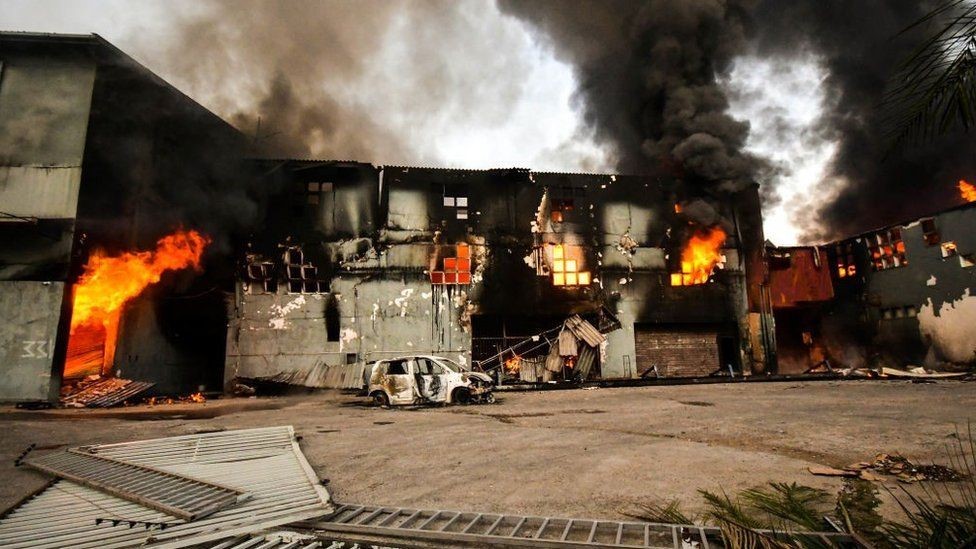
July 2021: KwaZulu-Natal’s largest city, Durban, in flames after unrest related to the succession of King Zwelithini and the arrest of former president Jacob Zuma[145]
It is clear that the state is too weak vis-à-vis the monarchy, and the provincial government, the product of a stunted agreement between a corrupt ANC with no leading figures and an IFP loyal to the King, is preventing problems from being resolved. The effect of all this is anarchy, the growing influence of criminal gangs, a deep division among the tribes (each nKhosi believes, not wrongly, that others are privileged and that his people are being kept hungry), social instability that casts doubt on the survival of the mining and logistics industries (plagued by constant murders, and AIDS due to the lack of any social policy and the increasing inability of the health system to reach where it is needed, an increasing number of school dropouts, the emergence of violent gangs controlling roads and food distribution centres. A chilling list.
One thing is clear: with his attitude, King Zwelithini has succeeded in putting the monarchy back at the centre of political and social life in KwaZulu-Natal, making it a protectorate of sorts, an area where South African laws are unenforceable if they displease the monarchy, but where the monarchy has no responsibility for the welfare of its subjects. This is the most serious of the unresolved issues: either the province is given independence, as was done with Swaziland, and at that point it is up to the Zulu subjects to decide whether to accept the continuing abuses of the Royal House, or the monarchy is again turned into a kind of institution for tourists – and at that point some of its whims are paid for, but ITB is dissolved and those who through the Trust have illegally enriched themselves are punished.
In this moment of suspension one waits for destiny to be fulfilled without political control or direction. After the death of the King, the monarchy itself is extremely weakened, because it has lost a leader who is aware of a goal to be achieved. In the next article we will tell you how this has turned KwaZulu-Natal into an open-air laboratory – and how the alliance between criminality and the most corrupt parts of the ANC are plotting to turn this pricelessly beautiful province into a new Transnistria.
[1] https://www.britannica.com/topic/Nguni
[2] https://www.britannica.com/topic/Sotho
[3] https://www.southafrica.net/za/en/travel/article/the-shangaan-tsonga-people
[4] https://www.britannica.com/topic/Venda-people
[5] http://countrystudies.us/south-africa/46.htm
[6] https://www.britannica.com/topic/Kraal
[7] https://www.sahistory.org.za/article/zulu
[8] https://www.sahistory.org.za/article/zulu
[9] https://www.afrikaiswoke.com/shakazulu-tv-series-review/
[10] https://best5.it/post/shaka-re-degli-zulu-1787-1828/
[11] https://www.sahistory.org.za/people/shaka-zulu
[12] https://www.sahistory.org.za/people/shaka-zulu
[13] https://www.sahistory.org.za/people/shaka-zulu
[14] https://www.britannica.com/biography/Dingiswayo
[15] https://www.sahistory.org.za/people/shaka-zulu
[16] https://amp.en.google-info.org/index.php/32732991/1/bulawayo-zulu-empire.html
[17] https://www.encyclopedia.com/international/encyclopedias-almanacs-transcripts-and-maps/zulu-empire
[18] https://best5.it/post/shaka-re-degli-zulu-1787-1828/
[19] https://www.treccani.it/enciclopedia/zululand_%28Enciclopedia-Italiana%29/
[20] https://www.jstor.org/stable/3171924
[21] https://theafricanhistory.com/1427
[22] https://hadithi.africa/why-king-shaka-zulu-was-one-of-the-greatest-military-leaders-in-history/
[23] https://hadithi.africa/why-king-shaka-zulu-was-one-of-the-greatest-military-leaders-in-history/
[24] https://www.britannica.com/topic/Dutch-East-India-Company
[25] https://www.sahistory.org.za/article/great-trek-1835-1846
[26] http://www.scielo.org.za/scielo.php?script=sci_arttext&pid=S0018-229X2011000200007
[27] https://www.britannica.com/event/Battle-of-Blood-River
[28] https://delphipages.live/it/storia-del-mondo/guerre-battaglie-e-conflitti-armati/battle-of-blood-river
[29] https://www.sahistory.org.za/people/andries-wilhelmus-jacobus-pretorius-0
[30] https://www.sahistory.org.za/dated-event/battle-blood-river
[31] https://www.south-africa-tours-and-travel.com/battle-of-blood-river.html
[32] https://southafrica.co.za/the-rise-of-the-zulu-empire.html ; http://uzspace.unizulu.ac.za/xmlui/handle/10530/839
[33] https://za.opera.news/za/en/military/863f13013d6fb6e63dd465e77f1db38d
[34] https://za.opera.news/za/en/military/863f13013d6fb6e63dd465e77f1db38d
[35] https://www.theguardian.com/world/2017/jan/26/boer-war-spion-kop-south-africa-1900-archive
[36] https://eshowe.com/battle-of-ndondakusuka/
[37] https://www.sahistory.org.za/people/king-mpande-kasenzangakhona
[38] https://www.english-heritage.org.uk/visit/blue-plaques/cetshwayo/
[39] https://biography.yourdictionary.com/sir-henry-bartle-edward-frere
[40] https://www.iheart.com/podcast/966-brief-history-of-wars-78413203/episode/zulu-wars-78440787/ ; https://www.sahistory.org.za/article/anglo-zulu-wars-1879-1896
[41] https://www.bbc.co.uk/history/british/victorians/zulu_01.shtml
[42] https://www.britishbattles.com/zulu-war/battle-of-khambula/
[43] https://www.britishbattles.com/zulu-war/battle-of-ulundi/
[44] https://www.nam.ac.uk/explore/garnet-wolseley
[45] https://www.anglozuluwar.com/images/Journal_22/The_Anglo-Zulu_War_of_1879_Unnecessarily_Destroyed.pdf “The Anglo Zulu War Unnecessarily Destroyed The Zulu Nation” – David Glyn-Fox –
[46] https://www.sahistory.org.za/people/king-dinuzulu
[47] https://www.anglozuluwar.com/images/Journal_22/The_Anglo-Zulu_War_of_1879_Unnecessarily_Destroyed.pdf “The Anglo Zulu War Unnecessarily Destroyed The Zulu Nation” – David Glyn-Fox –
[48] https://www.anglozuluwar.com/images/Journal_22/The_Anglo-Zulu_War_of_1879_Unnecessarily_Destroyed.pdf “The Anglo Zulu War Unnecessarily Destroyed The Zulu Nation” – David Glyn-Fox –
[49] https://www.battlefieldsregionguides.co.za/place/battle-of-ondini/
[50] https://www.1879zuluwar.com/t2793-john-dunn-the-white-chief-of-zululand
[51] https://www.sahistory.org.za/sites/default/files/archive-files/john_laband_historical_dictionary_of_the_zulu_wabook4me.org_.pdf “Historical Dictionaries Of War, Revolution And Civil Unrest” – Jon Woronoff, Series Editor – pp 54-55
[52] https://www.1879zuluwar.com/t948-dinuzulu-s-son-solomon-kadinuzulu
[53] https://modjourn.org/essay/the-boer-war/
[54] https://sciendo.com/article/10.1515/werk-2017-0003
[55] https://nzhistory.govt.nz/media/photo/battle-majuba-hill
[56] https://www.sahistory.org.za/article/discovery-gold-1884
[57] https://nzhistory.govt.nz/war/new-zealand-in-the-south-african-boer-war/a-brief-history
[58] https://www.sahistory.org.za/article/jameson-raid
[59] https://www.earthmagazine.org/article/benchmarks-october-11-1899-second-boer-war-begins-fueled-discovery-gold/
[60] https://soldiersofglos.com/announcement/the-siege-of-ladysmith/ ; http://www.storiain.net/storia/la-seconda-guerra-boera/ ; https://digilander.libero.it/fiammecremisi/schede/xxwar.htm ; https://blogs.loc.gov/maps/2018/06/the-rise-and-fall-of-the-orange-free-state-and-transvaal-in-southern-africa/ ; https://www.markedbyteachers.com/as-and-a-level/history/the-sieges-of-ladysmith-mafeking-and-kimberley.html
[61] https://modjourn.org/essay/the-boer-war/
[62] https://www.earthmagazine.org/article/benchmarks-october-11-1899-second-boer-war-begins-fueled-discovery-gold/
[63] https://modjourn.org/essay/the-boer-war/
[64] https://modjourn.org/essay/the-boer-war/
[65] https://www.earthmagazine.org/article/benchmarks-october-11-1899-second-boer-war-begins-fueled-discovery-gold/ ; https://www.sahistory.org.za/archive/peace-treaty-vereeniging-original-document
[66] https://www.historytoday.com/archive/peace-vereeniging
[67] https://mubulahistory.blogspot.com/2017/01/zulu-kingdom-under-mpande-1840-1872.html
[68] https://www.ilbullone.org/2020/07/22/il-regime-dellapartheid-tra-razzismo-e-segregazione/
[69] https://www.tandfonline.com/doi/abs/10.1080/02582470308671447
[70] https://www.sahistory.org.za/sites/default/files/archive-files/john_laband_historical_dictionary_of_the_zulu_wabook4me.org_.pdf “Historical Dictionaries Of War, Revolution And Civil Unrest” – Jon Woronoff, Series Editor – page 55
[71] https://www.sahistory.org.za/article/constructing-union-south-africa-negotiations-contestations-1902-10
[72] https://amp.en.google-info.in/31046077/1/franchise-and-ballot-act.html
[73] https://en-academic.com/dic.nsf/enwiki/11796206
[74] https://www.sahistory.org.za/article/constructing-union-south-africa-negotiations-contestations-1902-10
[75] https://sthp.saha.org.za/memorial/articles/the_transvaal_asiatic_registration_act.htm
[76] https://www.sahistory.org.za/article/african-peoples-organisation-apo
[77] https://www.britannica.com/event/South-Africa-Act
[78] https://www.treccani.it/enciclopedia/repubblica-sudafricana_%28Dizionario-di-Storia%29/ ; https://www.britannica.com/place/South-Africa/Reconstruction-union-and-segregation-1902-29
[79] https://www.britannica.com/topic/Mines-and-Works-Act
[80] https://www.greelane.com/it/humanities/storia–cultura/pre-apartheid-era-laws-43472/
[81] https://www.britannica.com/topic/Native-Urban-Areas-Act
[82] https://www.sahistory.org.za/article/founding-sannc
[83] https://www.britannica.com/biography/J-B-M-Hertzog
[84] https://www.sahistory.org.za/article/national-party-np
[85] https://www.sahistory.org.za/article/south-african-communist-party-sacp
[86] http://countrystudies.us/south-africa/46.htm
[87] https://www.accord.org.za/ajcr-issues/voting-and-violence-in-kwazulu-natals-no-go-areas/
[88] https://www.accord.org.za/ajcr-issues/voting-and-violence-in-kwazulu-natals-no-go-areas/
[89] https://theconversation.com/why-political-killings-have-taken-hold-again-in-south-africas-kwazulu-natal-143908
[90] https://www.gov.za/about-government/government-system/executive-authority-president-cabinet-and-deputy-ministers
[91] https://southafrica-info.com/infographics/provinces-homelands-south-africa-1996/
[92] https://www.bbc.com/news/world-africa-56370621
[93] https://www.sowetanlive.co.za/news/2012-01-24-zwelithini-taken-to-task-over-gay-slur/
[94] https://www.gov.za/documents/constitution-republic-south-africa-1996-chapter-12-traditional-leaders
[95] https://www.theguardian.com/world/2021/mar/22/king-goodwill-zwelithini-obituary
[96] https://mg.co.za/article/2019-08-07-secret-details-of-the-land-deal-that-brought-the-ifp-into-the-94-poll/
[97] https://www.refworld.org/docid/3ae6a84aa.html
[98] https://africasacountry.com/2018/12/the-emperor-has-no-clothes
[99] https://eshowe.com/king-goodwill-zwelithini-kabhekuzulu/
[100] https://eshowe.com/king-goodwill-zwelithini-kabhekuzulu/
[101] https://www.dailymaverick.co.za/article/2014-03-28-the-truth-elusive-shell-house-massacre-20-years-later/
[102] https://en.google-info.in/7371823/1/shell-house-massacre.html
[103] https://za.opera.news/za/en/politics/2ded128400f2b237390a475379630380
[104] https://www.iol.co.za/news/south-africa/eleven-get-amnesty-for-shell-house-massacre-45581
[105] https://ourconstitution.constitutionhill.org.za/the-shell-house-massacre-and-the-road-to-the-ifps-participation-in-the-election/
[106] https://www.tandfonline.com/doi/abs/10.1080/02582473.2021.1909115?journalCode=rshj20
[107] https://mg.co.za/article/2019-08-07-secret-details-of-the-land-deal-that-brought-the-ifp-into-the-94-poll/
[108] https://www.tandfonline.com/doi/full/10.1080/02582473.2021.1909116
[109] https://www.sahistory.org.za/dated-event/south-africas-first-democratic-elections
[110] https://www.ingonyamatrust.org.za/wp-content/uploads/2015/10/Ingonyama-Trust-Act-as-amended.pdf
[111] https://africasacountry.com/2018/12/the-emperor-has-no-clothes
[112] https://mg.co.za/article/2019-08-07-secret-details-of-the-land-deal-that-brought-the-ifp-into-the-94-poll/
[113] https://www.gov.za/sites/default/files/gcis_document/201409/a9-97.pdf
[114] https://www.gov.za/documents/kwazulu-natal-ingonyama-trust-amendment-act
[115] https://www.golegal.co.za/pto-rural-land-occupation/
[116] https://www.news24.com/citypress/trending/books/extract-king-zwelithini-receives-millions-but-is-it-money-well-spent-20180824
[117] http://www.scielo.org.za/scielo.php?script=sci_arttext&pid=S1727-37812020000100031#:~:text=The%20South%20African%20customary%20land,permanent%20communal%20land%20tenure%20legislation. ; https://www.gov.za/sites/default/files/gcis_document/201409/act31of1996.pdf
[118] https://mistra.org.za/wp-content/uploads/2021/01/MISTRA-Land-Delius_Beinart.pdf “Rights to Land: a guide to tenure upgrading and restitution in South Africa” – William Beinart, Peter Delius and Michelle Hay – Jacana Media, 2017 – Page 84
[119] https://nationalgovernment.co.za/units/view/110/ingonyama-trust-board
[120] https://www.customcontested.co.za/kgalema-motlanthes-high-level-panel-calls-for-repeal-of-ingonyama-trust-act/
[121] https://www.sowetanlive.co.za/news/south-africa/2018-11-07-zulu-king-slapped-with-lawsuit-over-land-in-kzn/
[122] https://www.sigrid-rausing-trust.org/Grantees/Grantee-1208
[123] https://www.wsj.com/articles/south-africa-wrestles-over-zulu-kings-vast-landholdings-11570186801
[124] https://www.timeslive.co.za/news/south-africa/2019-02-14-king-zwelithinis-trust-needs-more-time-to-deal-with-lawsuit-over-land/
[125] https://www.news24.com/citypress/news/casac-takes-on-zwelithinis-trust-20190803
[126] https://www.washingtonpost.com/politics/2021/05/28/south-africas-zulu-nation-is-riveted-by-royal-succession-drama-its-about-more-than-who-takes-throne/
[127] https://www.customcontested.co.za/the-ingonyama-trust-tramples-on-the-democratic-rights-of-citizens/
[128] https://www.timeslive.co.za/news/south-africa/2019-02-14-king-zwelithinis-trust-needs-more-time-to-deal-with-lawsuit-over-land/
[129] https://www.washingtonpost.com/politics/2021/05/28/south-africas-zulu-nation-is-riveted-by-royal-succession-drama-its-about-more-than-who-takes-throne/
[130] https://www.dailymaverick.co.za/opinionista/2020-12-08-time-for-the-ingonyama-trust-board-to-explain-how-it-manages-its-land/
[131] https://www.citizen.co.za/news/south-africa/government/2431534/arrogant-ingonyama-trust-under-fire-for-irregular-expenditure-mismanagement/
[132] https://www.newframe.com/king-zwelithinis-reckless-use-of-personal-power/
[133] https://www.groundup.org.za/media/uploads/documents/itb_judgment_11_june_2021.pdf
[134] https://www.news24.com/news24/columnists/guestcolumn/opinion-dr-fani-ncapayi-ingonyama-trust-and-board-hit-hard-by-high-court-judgment-20210628
[135] https://www.news24.com/news24/columnists/guestcolumn/opinion-dr-fani-ncapayi-ingonyama-trust-and-board-hit-hard-by-high-court-judgment-20210628
[136] https://www.groundup.org.za/article/zulu-kings-trust-pay-back-millions/
[137] https://buzzsouthafrica.com/late-zulu-king-goodwill-zwelithini-had-six-wives-in-his-lifetime-meet-them-all/
[138] https://www.timeslive.co.za/news/south-africa/2019-07-26-10-years-on-why-isnt-the-zulu-king-financially-self-sufficient/
[139] https://www.timeslive.co.za/news/south-africa/2019-07-26-10-years-on-why-isnt-the-zulu-king-financially-self-sufficient/
[140] https://www.timeslive.co.za/politics/2014-12-22-zulu-king-blows-r54-million-now-wants-more-of-your-money/
[141] https://www.timeslive.co.za/politics/2014-12-22-zulu-king-blows-r54-million-now-wants-more-of-your-money/
[142] https://www.timeslive.co.za/news/south-africa/2019-07-26-10-years-on-why-isnt-the-zulu-king-financially-self-sufficient/
[143] https://www.timeslive.co.za/sunday-times-daily/opinion-and-analysis/2021-12-16-game-of-thrones-a-battle-for-zulu-riches/
[144] https://www.news24.com/witness/news/kzn/kzn-premier-hands-over-six-cars-to-the-queens-of-the-late-king-goodwill-zwelithini-20211217
Leave a Reply